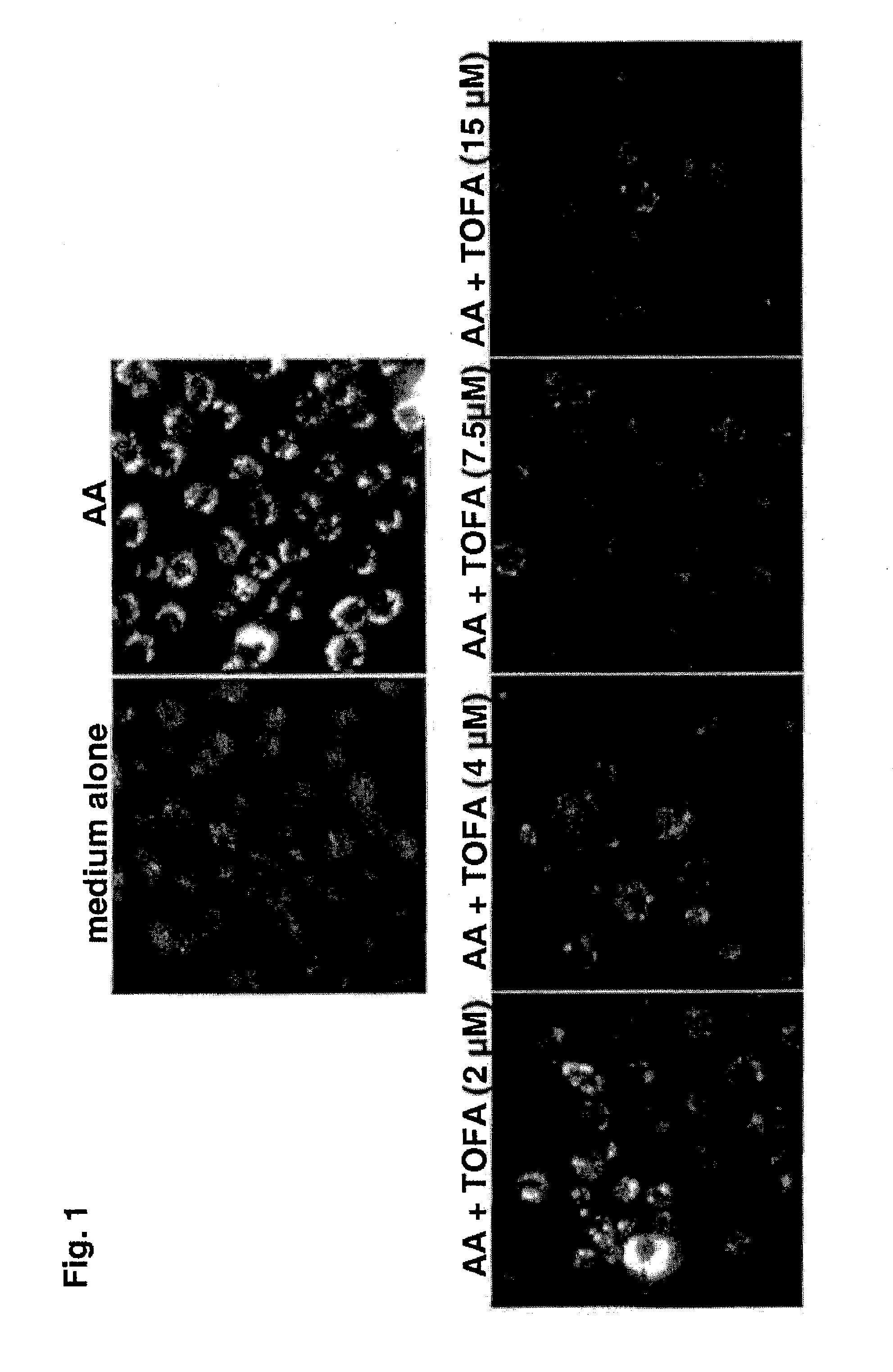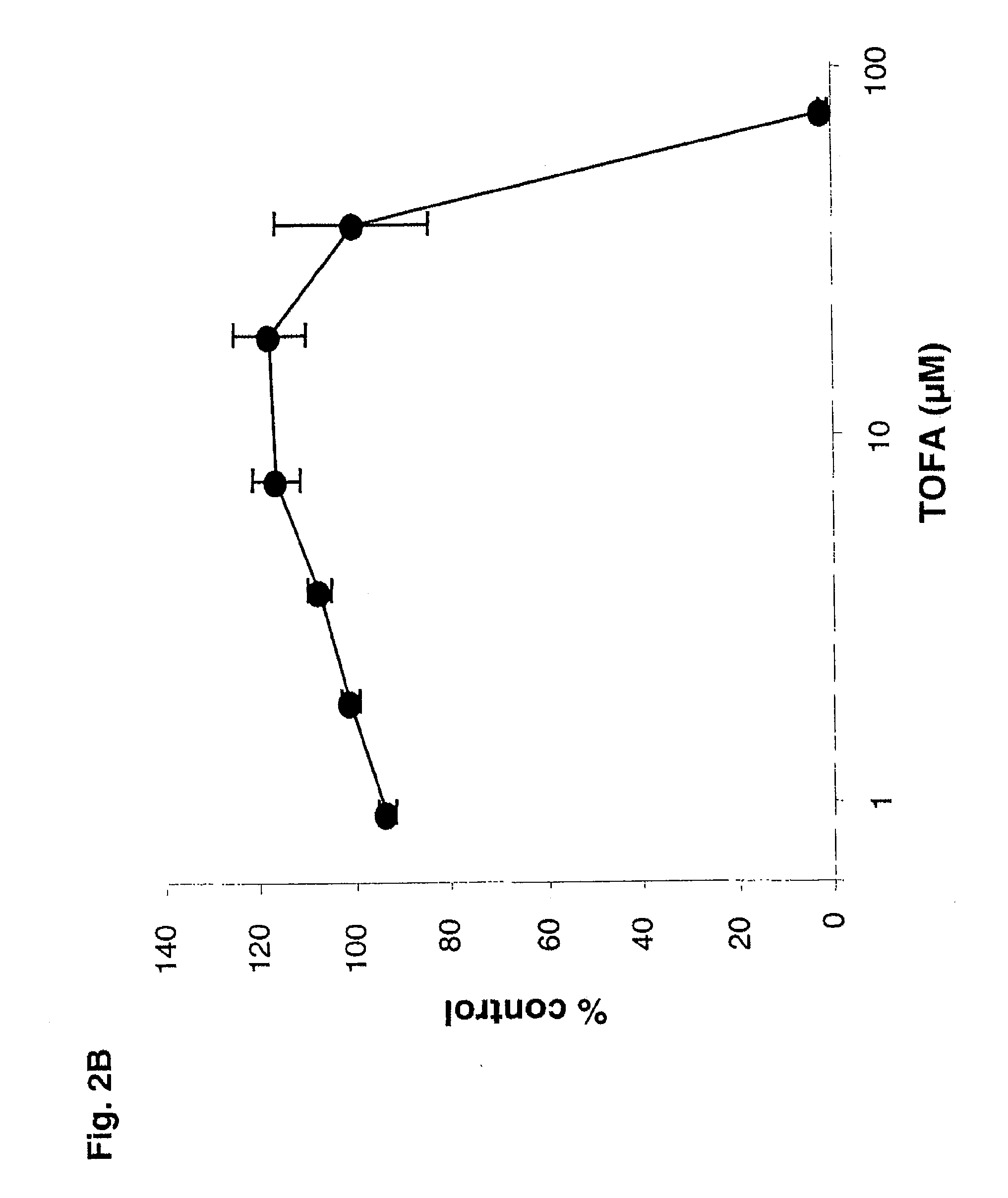Methods of treating dermatological disorders or conditions
a dermatological disorder and treatment method technology, applied in the field of 5(tetradecyloxy)2furancarboxylic acid, can solve the problems of long-term consequences, significant deficiencies in the currently available acne treatment options, and dermatological treatment options that are not fully effectiv
- Summary
- Abstract
- Description
- Claims
- Application Information
AI Technical Summary
Benefits of technology
Problems solved by technology
Method used
Image
Examples
example 1
Inhibition of Lipid Synthesis in SZ95 Sebocytes
SZ95 Sebocyte Culture and Induction of Lipid Synthesis
[0099]The immortalized human sebocyte cell line, SZ95, was maintained in culture as described in Zouboulis, C. C. et al., J. Invest. Dermatol. (1999), Vol. 113, pp. 1011-1020. Lipid synthesis was stimulated by treating SZ95 cells with arachidonic acid (AA). For measurement of lipid production and lipid inhibition studies, test compounds were dissolved in dimethylsulfoxide (DMSO) and added at the desired concentration in 96-well microtiter plates. The cells were then cultured for up to 72 hours before the plates were washed 3 times with PBS and a final volume of 200 μL PBS / well was added. To stain cell neutral lipids, 5 μL of Nile Red solution (0.2 mg / mL dissolved in DMSO) was added to each well and incubated for a minimum of 60 minutes. Plate fluorescence was then quantified using a fluorometric plate reader (excitation wavelength: 490 nm; emission wavelength: 590 nm). Inhibition of ...
example 2
Effect of TOFA on Lipid Accumulation by LNCaP Cells
Culture and Stimulation of Lipid Droplet Formation in LNCaP Cells
[0103]The human prostate LNCaP adenocarcinoma cell line was obtained from American Type Culture Collection. Cells were maintained in RPMI 1640 medium containing 10% fetal calf serum (FCS), 4 mM Glutamax, 1 mM sodium pyruvate, 1 mM HEPES, penicillin (100 U / mL) and streptomycin (100 μg / mL). For experiments, approximately 10,000 cells / well were plated in 6-well tissue culture plates in RPMI 1640 10% FBS for 72 hours. To minimize potential serum androgen effects, medium containing 5% charcoal / dextran-stripped FCS was added for 72 hours. Lipid synthesis was then stimulated by addition of the androgen dihydrotestosterone (DHT) at 50 nM. TOFA was solubilized in DMSO and added at various concentrations in RPMI 1640 containing 5% charcoal / dextran-treated. Cells were incubated in the presence of these factors for 96 hours at 37° C. Lipid accumulation was subsequently quantified ...
example 3
Effect of TOFA on 3T3-L1 Adipocyte Differentiation and Lipid Accumulation
Culture and Adipocyte Differentiation of 3T3-L1 Cells
[0106]Mouse 3T3-L1 preadipocytes (American Type Culture Collection) were passaged and maintained in Dulbecco's modified Eagles Medium (DMEM) supplemented with 10% fetal calf serum (FCS), 1 mM sodium pyruvate, penicillin (100 U / ml) / streptomycin (100 μg / ml) and 4 mM Glutamax (Gibco / Life Technologies). To initiate adipocyte differentiation, 3T3-L1 cells were plated at confluency into culture plates or dishes and grown in supplemented DMEM for two days post-confluency. Initiation medium consisted of DMEM with 0.5 mM 3-isobutyl-1-methylxanthine, 1 μM dexamethasone and human insulin at 10 μg / ml. Progression medium contained insulin (10 μg / ml) which replaced the initiation medium after 48-72 hours. Cellular lipid was imaged by Oil Red 0 staining as described in Example 2 for LNCaP cells.
Results
[0107]For mouse 3T3-L1 adipocytes, TOFA exerted dose-dependent effects on...
PUM
| Property | Measurement | Unit |
|---|---|---|
| Fraction | aaaaa | aaaaa |
| Acidity | aaaaa | aaaaa |
| Dimensionless property | aaaaa | aaaaa |
Abstract
Description
Claims
Application Information
 Login to View More
Login to View More - R&D
- Intellectual Property
- Life Sciences
- Materials
- Tech Scout
- Unparalleled Data Quality
- Higher Quality Content
- 60% Fewer Hallucinations
Browse by: Latest US Patents, China's latest patents, Technical Efficacy Thesaurus, Application Domain, Technology Topic, Popular Technical Reports.
© 2025 PatSnap. All rights reserved.Legal|Privacy policy|Modern Slavery Act Transparency Statement|Sitemap|About US| Contact US: help@patsnap.com



